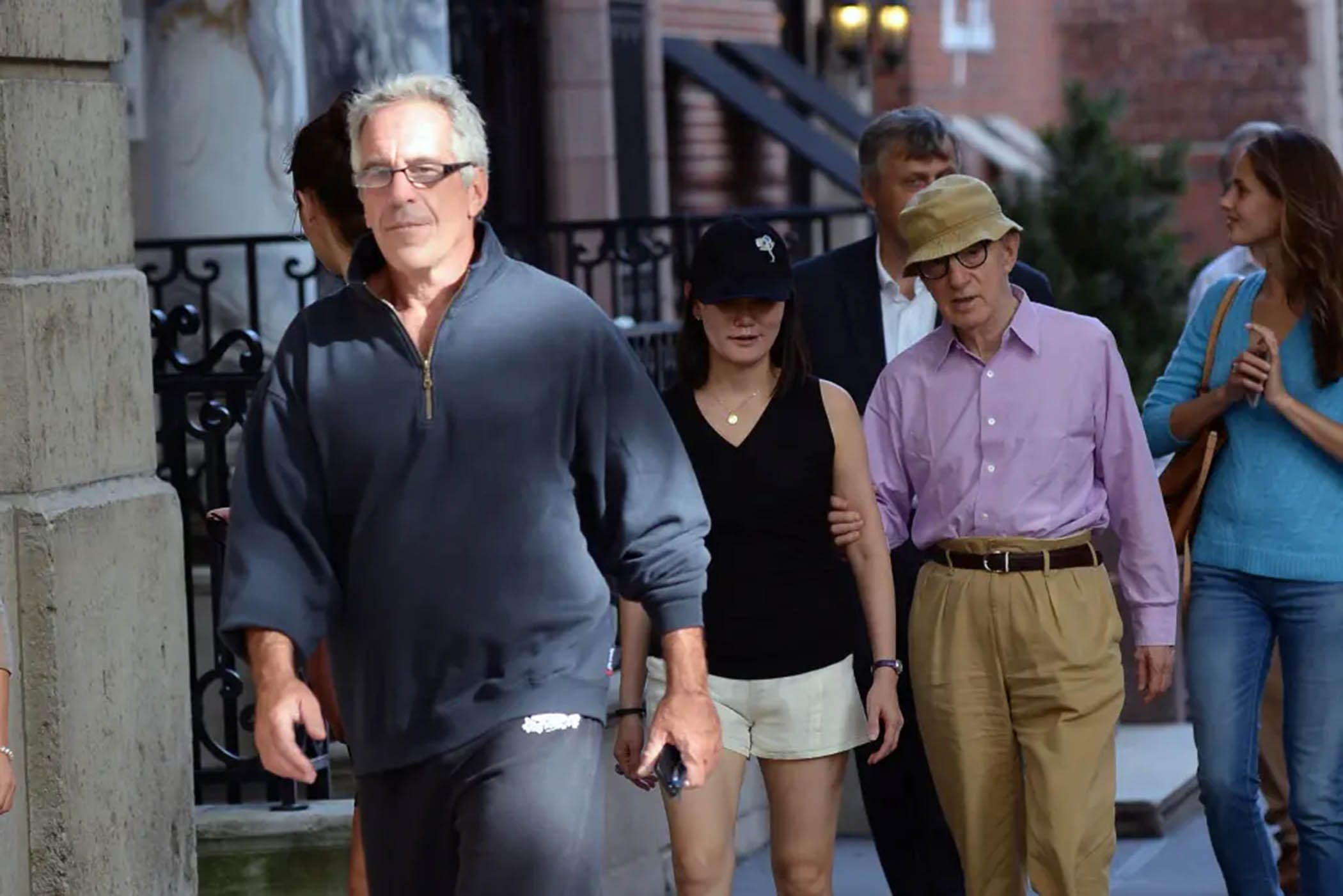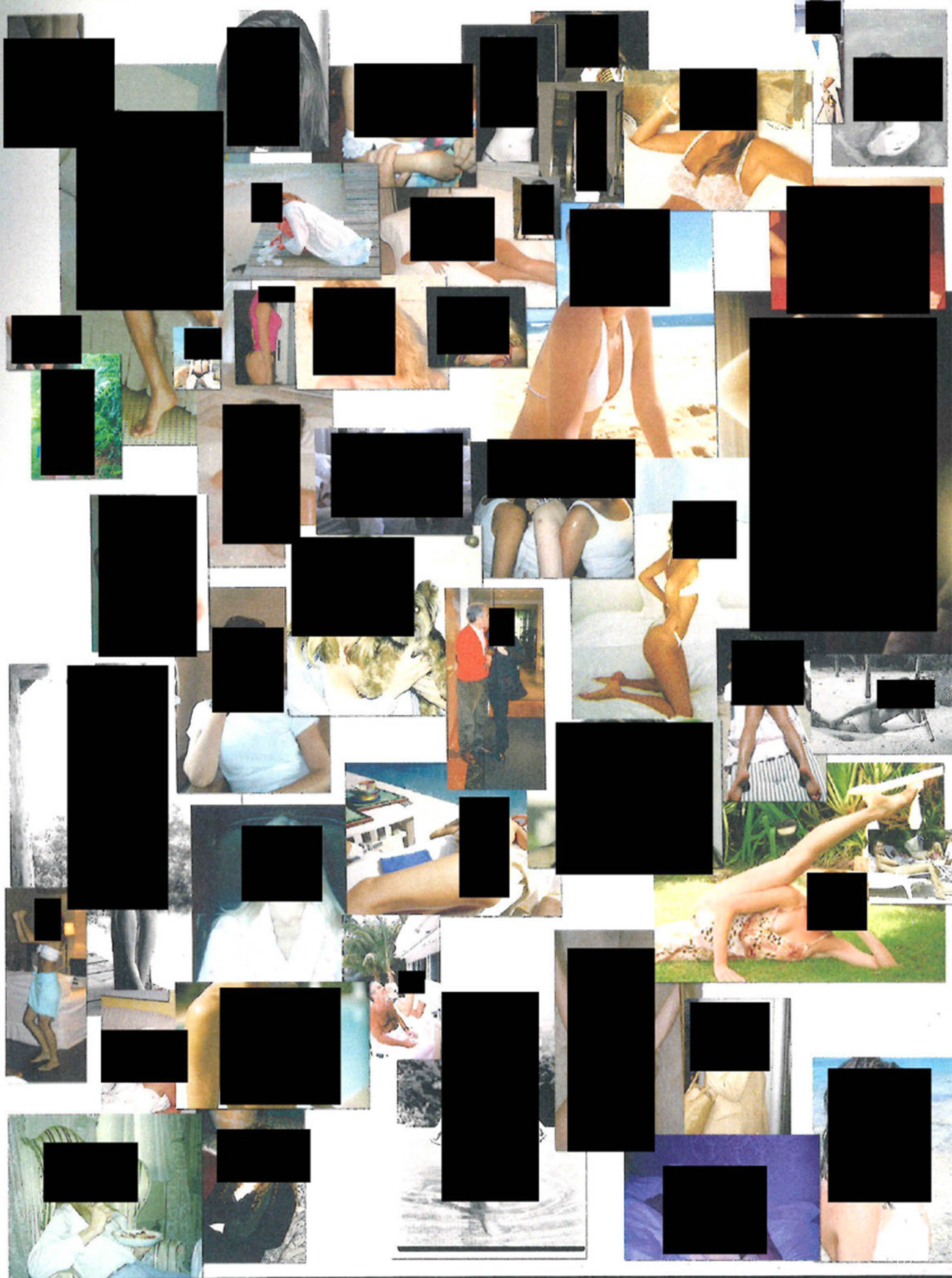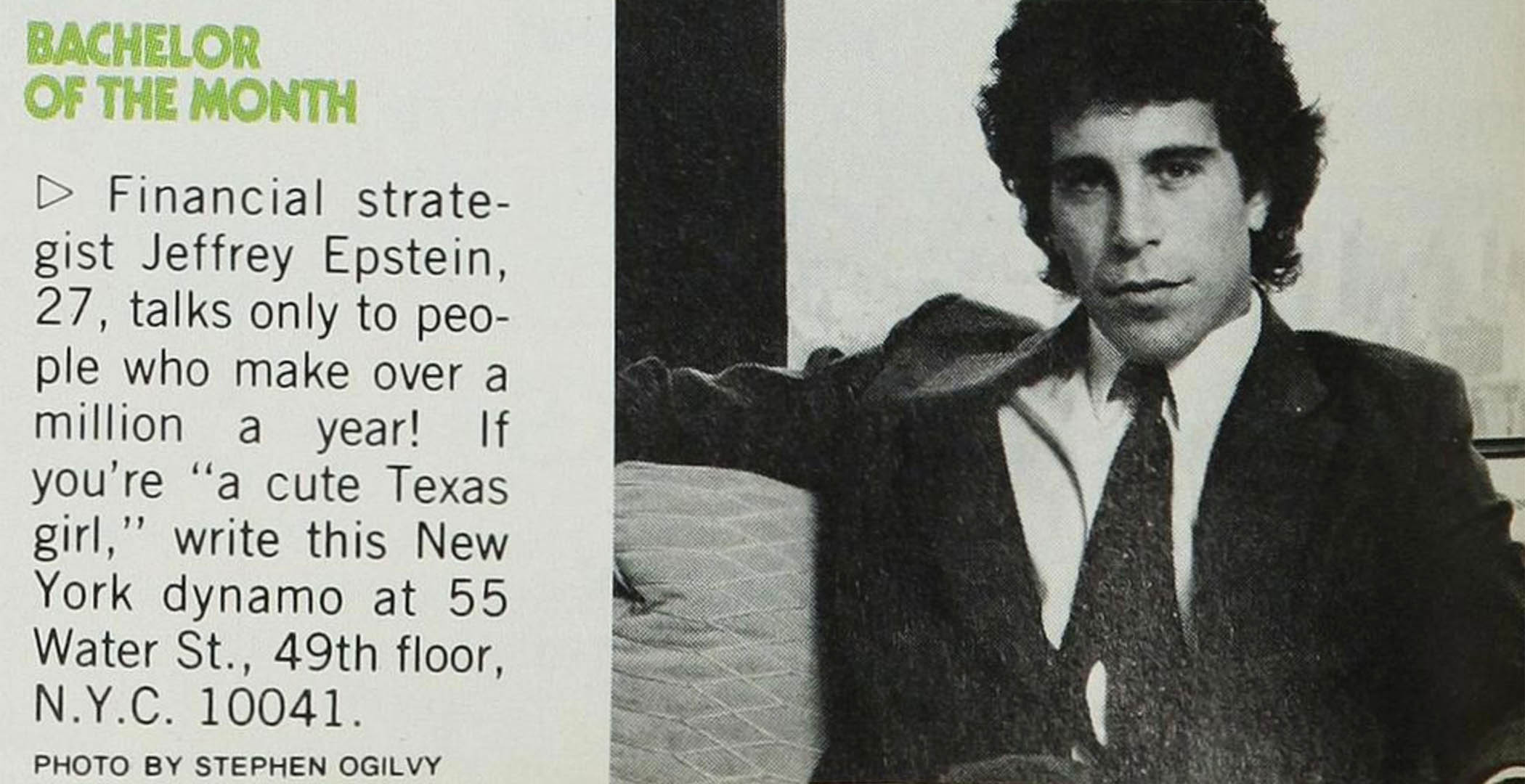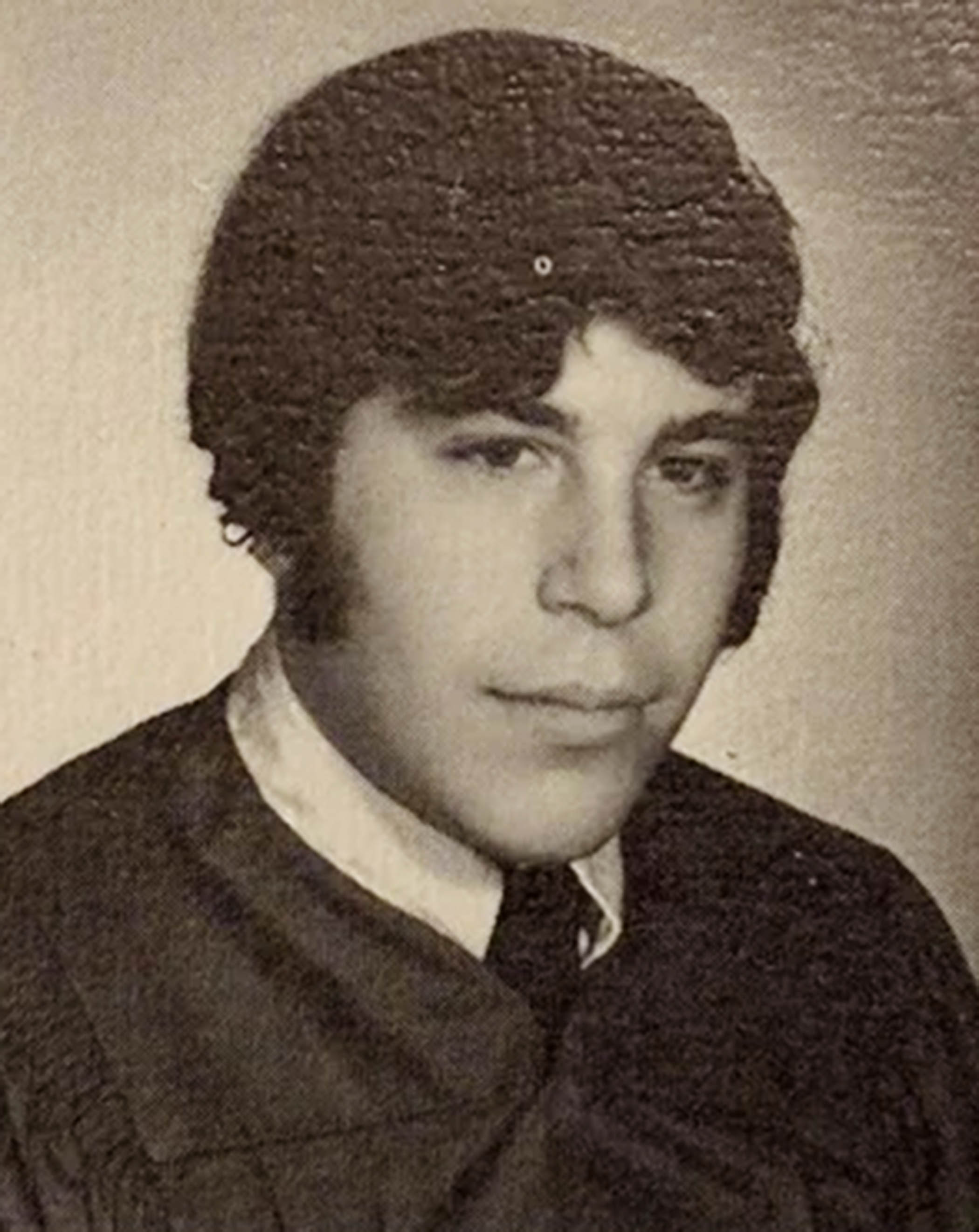It’s hard to trace Jeffrey Epstein through the thickets of material. You need a great writer, and we have one, sort of: Woody Allen, his neighbour in New York City, who sometimes dined at Epstein’s house. Epstein apparently disliked restaurants, having agoraphobic tendencies and a desire for low temperatures. Sleeping at 12C (54F) was his ideal: milk sours at that temperature but not Epstein. In 2016, eight years after Epstein was jailed for procuring a child for prostitution, Allen wrote a letter to honour his 63rd birthday. It is fascinating: a paradigm of unseeing – and that is the story.
Epstein liked letters: when you don’t think people are real, objects hold you. They are all you have. When Epstein was asked to leave the Bear Stearns investment bank in 1981, probably for dishonesty, he took a piece of paper with him, naming him Cosmopolitan’s bachelor of the month (July 1980). The caption reads: “Financial strategist Jeffrey Epstein, 27, talks only to people who make over a million a year! If you’re a ‘cute Texas girl,’ write this New York dynamo.” If he is Citizen Kane, the press cutting is his Rosebud. In the photograph, he looks like Fred West washed.
Allen’s letter isn’t really about Epstein: like all psychopaths, Epstein is a blank or a mirror. Words slide off him: even the testimony of his victims sounds partial, and numb. But they were children. I have read many books about Epstein, and I can’t find him in them. It’s like looking for Carrie Bradshaw’s journalism in Sex and the City, a show Epstein loved. It is as if he wasn’t there.
And so Allen’s letter about Epstein is about Allen, and I think there is something in that. I wonder if, when you looked at Epstein, you saw yourself and what you wanted. (He talks only to people who make over a million a year!) I wonder if, when you see that much money – Epstein seemed to look to Louis XIV for inspiration; he had a tapestry of him in his bedroom, a boy kneeling by the king – you cannot see anything else.
Allen wrote about Epstein as a beast to be civilised, specifically by Allen’s wife, Soon-Yi Previn. That is: he wrote about himself. It’s food criticism, not portraiture: Allen, peevish, writes about his stomach. That he talks about his own comfort is typical. Allen has always starred in his own jokes: there are bad narcissists and worse ones. There were, he wrote of Epstein’s dinners, “lots of dishes, plenty of choices, numerous desserts, well served”. I remind you: this was the house of a man jailed for procuring a child for prostitution, eight years before. “I say well served,” Allen writes, “often it’s by some professional houseman and just as often by several young women [reminding] one of Castle Dracula where [Bela] Lugosi has three young female vampires who service the place. Add to this that Jeffrey lives in a vast house alone, one can picture him sleeping in damp earth. But back to the food.” This is a joke. A bad one. “Dependably a fine dinner but this was not always the case.”

Epstein pictured with Woody Allen and his wife, Soon-Yi Previn, in 2013
Before Previn’s intervention, Allen says, no drinks were served at Epstein’s house. You could only get one if you asked for one. We know his pleasures lay elsewhere: he had cupboards full of naked photographs of underage girls. He needed to ejaculate three or four times a day, the victims tell us: essentially, he lived to rape. Epstein did not drink alcohol, did not take drugs and, according to one of his victims, Virginia Giuffre, liked food that would bore you to death: tofu, salmon, chickpeas. Hitler’s dinner parties come to mind.
Under Previn’s “badgering”, writes Allen, “the situation gradually improved and subsequent dinners offered buckets of Chinese food ordered from a local restaurant and placed out on a buffet where one could get in line and help oneself. It all seemed odd for a man of substance who entertained many illustrious guests often.” Now Allen writes like a man who is asleep.
Previn helped Epstein feed Allen. “Arrangements were made for food to be cooked at home and served. She had to explain the order in which things come out. Not the main course and then the appetiser but the other way around. In time she bullied him into putting a few flowers in the middle of the table to make it look mildly warm and inviting. This took time,” Allen adds, “and a number of corrections, but his meals have been tweaked into some sense of normal, civil dining. The large phone and computer at his right hand does take some of the relaxed home-cooking atmosphere out of it but one can’t have everything” – and here is his writer's flourish – “not at Castle Dracula”. Allen wasn’t wrong: Epstein was even allergic to garlic. I think Allen knew. Perhaps he didn’t know he knew, but he knew. I think they all did.
Epstein has no origin story to explain him – that is why he is so frightening. There was no purpose to him, no meaning. He just happened. Giuffre, who lived with him for two years and whose posthumous memoir, Nobody’s Girl, was published last month – in April she killed herself, because some women don’t forgive themselves for being raped – once asked Epstein if he was abused as a child. He didn’t reply, but Giuffre suspects he was. Perhaps she needed to believe that. Perhaps she would know.
Epstein grew up in Sea Gate, Coney Island, across the water from New York, the child of Seymour, a gardener and Pauline, a housewife. If you don’t believe Giuffre’s theory about Epstein’s childhood trauma, then perhaps it is just this: American-Jewish suburbia. Epstein’s life is treated as a crime scene – crime books are outsold only by romance fiction in the US – which is why I have seen a photograph of the childhood bedroom he shared with his brother, Mark. It is cramped and ordinary: invited to see it through Epstein’s eyes, searching for his motive, it is horrifying in its smallness.

A page from Epstein’s 50th birthday book
To Jewish immigrants fleeing persecution in Europe, Sea Gate was Elysium. The novelist Isaac Bashevis Singer lived there in the 1930s and wrote: “I looked out of my window at the Atlantic and watched such world‐famous ships as the Queen Mary, the Ile de France and … the Normandie, sail by. After the shabby Warsaw streets, the environs of Sea Gate seemed to me to be the height of luxury.” He was so bewitched that he “developed a new phobia – that Coney Island would spread and envelop the world … The Wailing Wall, the Vatican, even death itself would become a part of Coney Island.” But Bashevis Singer would say that –; he was a novelist. “The ocean of Sea Gate was a literary sea,” he wrote. “Sometimes when the sky was overcast and the water grew dark, I imagined it was a sea of ink.” Epstein’s internal universe was infinitely smaller.
Elysiums fade, and change. By the time Epstein lived there, Sea Gate did not compare itself to bloodied Europe, but to Manhattan and its gold. Epstein was a blank waiting to be filled. “I’m going to be rich when I grow up,” he told a high school classmate, according to Barry Levine’s biography The Spider.
He dropped out of college and taught calculus and physics at the Dalton school. He was hired by Donald Barr, author of Space Relations, a novel about extraterrestrial BDSM – it was the 1970s. There he befriended Alan Greenberg, the man who ran Bear Stearns bank, and a parent; then he adopted Les Wexner, the man who owned Victoria’s Secret. Coin and corsetry: perfect for a pimp. An anecdote from Epstein’s youth has him stalking Kathy Suter, a former high school girlfriend, on a date with another man, in a hired limousine. He later paid for her son’s education and she forgave him.
I read books about Epstein because he was speechless. He was a man without culture, and gauche. He liked computers and girls as young as 13; he put quotes from Mr Spock on the wall of the house. He would take girls to see The Phantom of the Opera on Broadway, an overture to what he would do to them later; he liked Whitney Houston and Céline Dion.
His books were slavery manuals: The Story of O; SM 101: A Realistic Introduction; SlaveCraft: Roadmaps for Erotic Servitude – Principles, Skills and Tools; Training with Miss Abernathy: A Workbook for Erotic Slaves and Their Owners; the Marquis de Sade’s The Misfortunes of Virtue; Vladimir Nabokov’s Lolita, presumably for its forgiveness: “Reader, she seduced me.” There are books for him to diagnose himself: Psychopathia Sexualis; Ontogeny and Phylogeny; Sex and Character. And Face Exercises That Prevent Premature Aging.
His art collection was telling and awful: a nude chess set representing female employees; a lifesize bride hanging from a rope; carved eyeballs; a prison mural featuring Epstein; the god Pan; Bill Clinton in Monica Lewinsky’s blue dress; a penis. His only good painting, a Max Weber, was a fake. Perhaps he didn’t care.
His bedroom in New York City was coherent in colour, but manic in style. He liked pink because, as he said: “Pink is for pussy!” Guiffre said his house in Palm Beach was painted the colour of Pepto-Bismol: heartburn medication. If he was sick, he liked his girls sicker: vulnerable, but with dreams.
Epstein has no origin story to explain him – that is why he is so frightening
To them, he was like a dirty Gatsby parsed through ChatGPT. He said things such as: “Do you take birth control?” And: “Tell me about your first time.” And: “I just want to help.” He would ask if they had fathers: usually they didn’t, so he would dress them as schoolgirls and ask them to call him “Daddy” or “Godfather”, though he also asked Giuffre to dress him as if he were an infant. (He told her: “You’ll make a good mom one day.” She left three children behind.) He liked girls to sleep at his feet and padded his floors for that purpose. He sometimes told them he was a doctor.
“I can teach you so many things,” he told Guiffre, lecturing her on sweat lodges. First came the rape; then came the Ted Talks. He loved girls who would collude. Giuffre writes that she once found a girl for him and put her in the bath. “I brought him to my bathroom and revealed my ‘big surprise’. When he saw the girl, he looked at me with such gratitude…” When Giuffre was offered a job by a billionaire, Epstein said: “That’s good money. How could you decline?” “I responded with my own question: ‘Who would look after you, if I were gone?’ I’ll never forget how he gazed at me that night.”
It wasn’t just Giuffre who was half-seduced: in Perversion of Justice, Julie K Brown, the reporter who broke the case, noted two girls in the 2005 investigation who said “they were in love with Epstein and would never betray him”. He kept Giuffre so long because she made him feel normal: but she was abused from the age of seven. She left him when he suggested she have a child but sign over parental rights to him and Ghislaine Maxwell. She feared it would be a girl.
The best book on Epstein is Lucia Osborne-Crowley’s The Lasting Harm, an account of Maxwell’s trial, because it is about the victims. They have speech, and Epstein didn’t. Rape was his speech. She tells the story of Carolyn, raped from the age of four and recruited by Giuffre at 14: they are both dead. Carolyn was so unsophisticated she couldn’t pronounce Ghislaine. She called her Maxwell.
Ghislaine was as emotionally dead as Epstein, but more talkative: that is, she hid it better. She was reportedly anorexic from the age of five. Her father, Robert Maxwell, a killer – in the war, he executed German civilians and soldiers trying to surrender – beat his children but would let them choose what they were beaten with: slipper, hairbrush, cane? Ghislaine was his favourite, a curse. I don’t think Epstein’s lure for Maxwell was money: or not just money. Perhaps she thought it was love. Carolyn tried to tell Maxwell a man raped her. “Honey, it wasn’t rape,” Maxwell said. “You were willing.” When Carolyn was pregnant, Epstein masturbated over her stomach.
In The Lasting Harm, a dancer asks Epstein why he hired her to massage him. “Dancers know the body so well, they are always in shape, they are the best masseuses,” he replies. “You wouldn’t hire a fat personal trainer, would you? And dancers are comfortable with nudity. In some of the places I’ve been, you wouldn’t just have one masseuse. You’d have three – one for the head, one for the feet and one right in the middle.” He told her to take off her dress; he assaulted her, saying: “It’s OK if you become sexually aroused”; and he left money on the table.

The Cosmopolitan article from 1980 stating that Epstein ‘talks only to people who make over a million a year’
“There was one thought that just kept ringing around in my head, over and over,” she told Osborne-Crowley. “I am so stupid, and I will never trust myself again.” She was on an upward trajectory when she met him; soon she had cystic acne on her face. The answer to her question – why a man as rich as Epstein didn’t hire professionals – is this: he didn’t want to. It wouldn’t hurt enough.
Osborne-Crowley writes that Maxwell found Elizabeth Stein, a victim, in the department store where she worked: as if she were a pair of shoes. When Liz took Maxwell’s packages to the St Regis hotel – hyper-capitalism is dependent on pleasing – she and Epstein allegedly assaulted her. Maxwell’s antennae for victims of child abuse – Liz was another – is uncanny. Liz returned to them, and would vomit to protect herself. They didn’t mind, because they liked her anguish. This is the most violent testimony I have read: Liz was raped by many people, battered and threatened with death. Even when she escaped, she received messages, saying they were watching. Her health is ruined. She has been hospitalised more than 30 times.
Epstein became famous in 2002, after a trip with Clinton and Kevin Spacey on Epstein’s Boeing 727. You could say that friendship – his version of it – destroyed him. Dracula is supposed to sleep alone. For Epstein’s 50th birthday the following year, Maxwell compiled a birthday book with contributions from “friends”. Epstein had no friends. Was Mr Spock in it?
Even so, Clinton, who travelled on Epstein’s jet at least 26 times, emitted verbiage: Epstein had, “a drive to make a difference”. Peter Mandelson called him “my best pal”, a disclosure that almost incites pity. Almost. Donald Trump provided a silhouette of a naked woman with the comment: “Enigmas never age, have you noticed that?” Trump now says it was faked. With such men nothing is real. They fell out but Epstein remained interested in Trump. It was revealed this month that he logged Trump’s movements and wrote to a New York Times journalist in 2018, “he [Trump] feels alone, and is nuts !!! , I told everyone from day one. evil beyond belief mad, and most thought it was speaking metaphorically, its obvious he could crack”.
In the birthday book is a bad drawing of Epstein buying lollipops for girls and holding balloons: the creature in It. One has JE stamped on her arse, for ownership.
This book’s twin is the manual for the house in Palm Beach, a horrifying document designed to be studied by the procured girls, and the best guide to what was inside Epstein: to the blank. The need. “Do not discuss personal problems with guests.” “You do not expound on the weather or any other subject, unless asked. You have no idea how they are feeling.” “To a compliment you say ‘Thank you, Ms _, I enjoy doing it.” “Remember that you see nothing, hear nothing, say nothing.” (The list of foodstuffs to be stocked reminds me of a story set in Robert Maxwell's rented mansion in Oxford, where Ghislaine grew up. A curious party guest opened a cupboard, hoping to understand Robert Maxwell, and found salad cream.) A final entry in the manual read: “SMILE!”

Epstein’s graduation photo from 1969
Much has been written on Epstein and the scientific community, which he courted, funded and sometimes gave young girls to. According to Giuffre, this baffled and upset one scientist, because not everyone is happy in – what is it, Valhalla? People think Epstein’s interest in the scientific community was the manifestation of his intellect, something he wore like a hat. But it was an entirely predictable thing: an extension of his will to rape. It was cryonics and seeding: posthumous rape. Through Harvard University’s programme for evolutionary dynamics, which he funded, he sought to cure the world of selfishness, and this is his only joke.
Epstein was only a pimp: the fascination, and the horror, is in watching people collude. Before he died, he told a fellow prison inmate what motivated him. “‘I’ll tell you… one thing: pussy.’ I’ll never forget him saying that.’’ He also said: “I don’t know what you’ve heard, but they are talking about these girls being underage, but they’re 15, 16, 17, and 18 years old – not eight or nine years old!” It is not that he wasn’t repentant: he didn’t know what repentance was. “I’m not a sexual predator; I’m an offender,” he said. “It’s the difference between a murderer and a person who steals a bagel.” Epstein hated bagels. Carbohydrates make you fat.
His last note is interesting too, for how uninteresting it is. It was in his cell, where he was found hanged (maybe suicide, maybe murder. Read enough about him and you won’t care). It was written in blue pen on yellow paper. “[--] kept me in a locked shower stall for 1 hour. Noel sent me burnt food. Giant bugs climbing over my hands. NO FUN!!” He is buried with his parents in Palm Beach county, Florida, but the names are scrubbed out: another vanishing.
But the real vanishing was societal. Epstein should never have left prison in 2008, but prosecutors protected him. In this you can read only how little the world has changed, because justice was partial, and there will be another Epstein. There is one among us now.
There is no mystery here; that is a soothing fiction. In The Lasting Harm, Osborne-Crowley relates how Elizabeth Stein travelled to Manhattan to hear the verdict in the Maxwell case in 2022. Victims are entitled to seats in courtrooms but only a fraction found justice; calls to the FBI with testimony were unanswered. That day, a court official told Osborne-Crowley in Stein’s presence: “Miss Stein did not actually testify at this trial so she’s not technically a victim.”
The women complained and a more senior court official came. “She’s not a victim,” he repeated.
“She is,” Osborne-Crowley said. “She applied to the Epstein victims’ compensation fund.”
“Well, she’s not registered with my office as a victim, so she’s not a victim.”
This is a retelling of Allen’s restaurant review of Castle Dracula: another brutal piece of unseeing. I think Epstein would have loved it.
Photographs by Elder Ordonez / SplashNews.com

